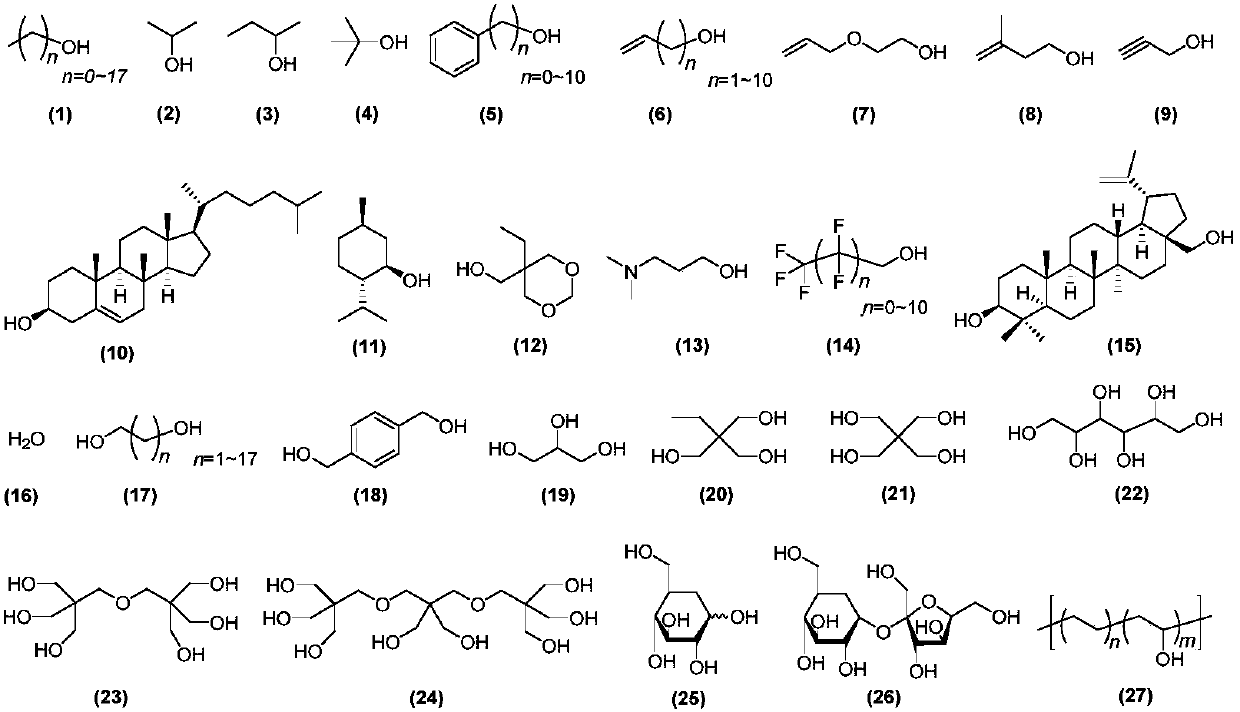Method for preparing polyether based on three-component metal-free catalytic initiation system
A technology of metal-free catalysis and initiation system, applied in the field of polyether synthesis, can solve the problems of low catalytic activity, ineffectiveness, destructive side reactions of polymerization efficiency, etc., and achieve the effect of narrow dispersion and adjustable molecular structure.
- Summary
- Abstract
- Description
- Claims
- Application Information
AI Technical Summary
Problems solved by technology
Method used
Image
Examples
Embodiment 1
[0040] The ring-opening polymerization of ethylene oxide is carried out with water as the initiator and organic Lewis acid-base couple as the catalyst to prepare polyethylene oxide glycol. The specific operation is as follows.
[0041] In an inert atmosphere, add 1 part (mole part) of purified water into a dry glass reactor. Continue to add phosphazene base t-BuP containing 0.01 parts 1 With 0.03 parts of triisopropylborane in tetrahydrofuran solution, stir and mix evenly. Connect the glass reactor to a vacuum line, remove part of the gas in the bottle, and cool down with an ice-water bath. Add 2400 parts of dry ethylene oxide at 0-4°C, seal the glass reactor and react at room temperature (20-25°C) for 24h. In this embodiment, the molar concentration of ethylene oxide is 20 mol / L, and after the ethylene oxide reaction is completed, it can be seen that a solid product is precipitated in the glass reactor. The reactor is opened, and the polyethylene oxide product is collecte...
Embodiment 2
[0044] The ring-opening polymerization of ethylene oxide was carried out with water as the initiator and organic Lewis acid-base couple as the catalyst to prepare non-cytotoxic polyethylene oxide diol. The specific operation is as follows.
[0045] Both tetrahydrofuran (THF) and ethylene oxide were used after water removal treatment. In an inert atmosphere, add 1 part of pure water to a dry glass reactor and add THF to dissolve. Continue to add t-BuP containing 0.1 part of phosphazene base 1 With 0.3 parts of tetrahydrofuran solution of triethylboron, stir and mix evenly. Connect the glass reactor to a vacuum line, remove part of the gas in the bottle, and cool down with an ice-water bath. Add 240 parts of dry ethylene oxide at 0-4°C, seal the glass reactor and react at room temperature for 3h. In this embodiment, the molar concentration of ethylene oxide is 12 mol / L. After the reaction is completed, the reactor is opened, and the polyethylene oxide product is taken out fr...
Embodiment 3
[0048] The ring-opening polymerization of ethylene oxide is carried out with water as initiator and organic Lewis acid-base couple as catalyst to prepare high molecular weight polyethylene oxide glycol. The specific operation is as follows.
[0049] In an inert atmosphere, add 1 part of pure water to a dry glass reactor and add THF to dissolve. Continue to add t-BuP containing 5 parts of phosphazene base 1 With 15 parts of tetrahydrofuran solution of triethylboron, stir and mix evenly. Connect the glass reactor to a vacuum line, remove part of the gas in the bottle, and cool down with an ice-water bath. Add 24,000 parts of dry ethylene oxide at 0-4°C, and react in a sealed glass reactor for 3 hours at room temperature. After the reaction is completed, the reactor is opened, and the polyethylene oxide product is taken out from the reaction bottle and vacuum-dried to obtain the product. The theoretical number average molecular weight M calculated by the ratio of ethylene oxi...
PUM
 Login to View More
Login to View More Abstract
Description
Claims
Application Information
 Login to View More
Login to View More - R&D
- Intellectual Property
- Life Sciences
- Materials
- Tech Scout
- Unparalleled Data Quality
- Higher Quality Content
- 60% Fewer Hallucinations
Browse by: Latest US Patents, China's latest patents, Technical Efficacy Thesaurus, Application Domain, Technology Topic, Popular Technical Reports.
© 2025 PatSnap. All rights reserved.Legal|Privacy policy|Modern Slavery Act Transparency Statement|Sitemap|About US| Contact US: help@patsnap.com



